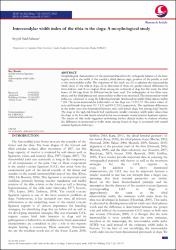Intercondylar width index of the tibia in the dogs: A morphological study
Citation
SABANCI Seyyid Said Intercondylar width index of the tibia in the dogs: A morphological study. Mehmet Akif Ersoy Üniversitesi Veteriner Fakültesi Dergisi 7, no.2 (2022): 102 - 107. 10.24880/maeuvfd.1076011Abstract
Morphological characteristics of the proximal tibia affect the orthopedic balance of the knee region. Such as the width of the condyles, tibial plateau angle, position of the patella; Intercondylar width is one of these features as well. The objectives of this study are to calculate the intercondylar width index of the tibia (ICWI) in dogs, to determine if there are gender-related differences in ICWI, and to compare the ICWI among the six breeds of dog. For these aims, the tibial bones of 84 dogs from 26 different breeds were used. The radiographs of tibias were taken, and the tibial plateau and intercondylar widths were measured. The intercondylar width index was calculated using the following formula: (intercondylar width/tibial plateau width) *100. The mean intercondylar width index of the dogs was 19.2±2.72. The index values of male and female dogs were 19.1±3.32 and 19.3±2.02, respectively. The significant differences in the index were not determined between male and female dogs, but the significant difference was determined among dogs’ breeds. The dogs in the high-risk breeds had significantly smaller eminence width index value than the dogs in the low-risk breeds related with the non-traumatic cranial cruciate ligament rupture. The results of this study suggested performing further clinical studies to evaluate whether the difference in intercondylar width index among breeds in dogs is associated with cranial cruciate ligament deficiency.


















